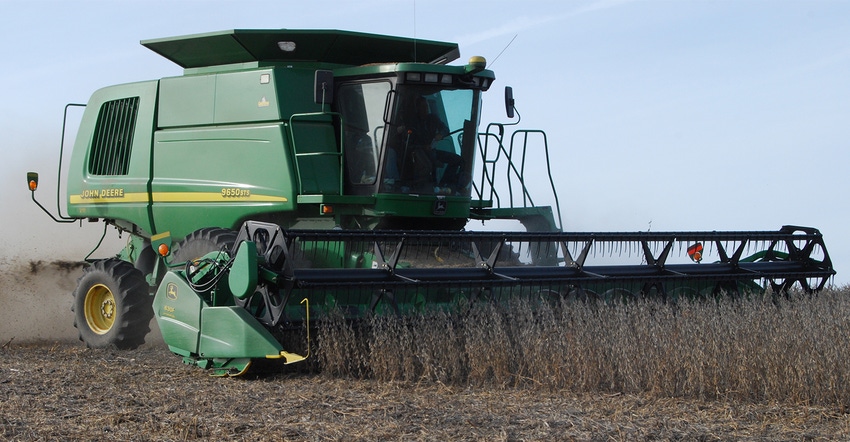
Continued mostly dry weather last week across Iowa allowed farmers to make more progress with the 2018 corn and soybean harvest. USDA’s survey for the week ending Oct. 28 shows Iowa now has 49% of its corn in the bin, but that’s still behind the five-year average of 57% for late October. Iowa has 71% of its soybean crop harvested, compared to an 86% average for the past five years.
The U.S. corn harvest is now 63% complete, equal to its five-year average. The nation’s soybean harvest is 72% done, and behind its five-year average of 81%. Nebraska is finished with 47% of its 2018 corn harvest, compared to a five-year average of 55%. Illinois and Indiana farmers have harvested 89% and 77% of their corn, respectively, ahead of their five-year averages.
In south-central Iowa, farmer Randy Miller was harvesting soybeans last week. They were yielding a little better than he thought they would, considering the delayed harvest due to wet weather in previous weeks. The yield monitor in his combine was registering 52 bushels per acre and 10.5% moisture content in the best areas of the field. But the field was averaging only 42 bushels an acre overall, when low-yield areas were figured in.
“Our bean yields this year aren’t as good as I thought they’d be when we first began harvesting in September,” he says. Then the rains came and kept coming, postponing harvest, and bean plants were turning black; beans in pods began sprouting and shattering in some fields. “It’s hard to be positive as crop conditions deteriorated this fall,” Miller says. “Many of the extra bushels I was counting on to make up for lower prices are gone. Plus, myself and a lot of other farmers are getting docked for lower-quality beans when soybeans are sold — due to soybean mold and related issues caused by the prolonged wet weather.”
The Iowa Farm Bureau and Decision Innovation Solutions have analyzed Iowa Crop Progress & Condition Reports going back to 1990, looking at the largest week of corn and soybean harvest each year. Additional information about their analysis can be found here.
The complete weekly Iowa Crop Progress & Weather Report is available on the Iowa Department of Agriculture and Land Stewardship website or on USDA’s site.
Crop report
Iowa farmers had a good week for harvesting, with 5.8 days suitable for fieldwork during the week ending Oct. 28, according to USDA’s National Agricultural Statistics Service. Taking advantage of the dry conditions, activities for the week included harvesting corn and soybeans, baling stalks, applying anhydrous and manure, doing fall tillage, and planting cover crops.
Topsoil moisture rated zero percent very short, zero percent short, 79% adequate and 21% surplus. Subsoil moisture levels rated zero percent very short, 1% short, 73% adequate and 26% surplus.
As of Oct. 28, 49% of Iowa’s corn for grain crop has been harvested, three days ahead of last year but three days behind the five-year average. Farmers in southeast Iowa have harvested 65% of their corn for grain, while farmers in northeast and southwest Iowa are yet to cross the 40% mark on their corn for harvest.
Moisture content of field corn being harvested averaged 18% for Iowa last week. Corn condition rated 69% good to excellent. Soybean harvest was 71% complete, a week behind the average. This is the smallest percentage of the soybean crop harvested by Oct. 28 since 2009.
Pasture conditions are rated 52% good to excellent statewide. With less rain, cattle feedlots are drying to more favorable conditions.
Weather summary
Unseasonably cool and dry conditions continued across Iowa during October’s last full week, according to Justin Glisan, IDALS climatologist. Temperatures were generally near normal in western Iowa and up to 4 degrees cooler than normal in eastern Iowa. Statewide precipitation deficits were largest in southeast Iowa. Average rainfall was around 0.12 inch; normal for the week is 0.56 inch.
A warm Monday, Oct. 22, began the week, with highs averaging between the mid-60s and lower 70s. A cold front dropped through Iowa on Oct. 23, bringing cooler temperatures and pleasant conditions. Highs were generally in the 50s, with overnight lows dropping into the upper 20s and lower 30s. Spotty rain showers moved into extreme western Iowa late on Oct. 24, with measurable rainfall between 0.1 and 0.25 inch. Light rain lingered into Oct. 25, with highest two-day totals confined to Iowa’s western third, ranging between 0.05 and 0.5 inch.
Oct. 26 and Oct. 27 were generally dry, though a weak warm front ahead of a surface low over Minnesota produced isolated showers in eastern Iowa. Highs were in the upper 60s, with cloud cover keeping temperatures cooler in the northeast. As the low propagated east, a cold front moved through early on Oct. 28, bringing light rainfall to the northeast two-thirds of Iowa. Behind the front, clear to mostly sunny conditions prevailed with very gusty winds across Iowa’s eastern half. Under clear skies, overnight lows dropped into the upper 20s.
The week’s high temperature of 73 degrees F was reported at De Soto (Harrison County) on Oct. 26, which is 13 degrees above average. Elkader (Clayton County) and Stanley (Buchannan County) observed the week’s overnight low temperature of 19 degrees on Oct. 22, 16 degrees below normal. The highest weekly total rainfall accumulation of 0.62 inch was observed at Shenandoah (Page County).
About the Author(s)
You May Also Like




